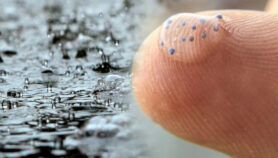By: Bernard Dixon
Send to a friend
The details you provide on this page will not be used to send unsolicited email, and will not be sold to a 3rd party. See privacy policy.
Rising temperatures, which promote algal blooms and the spread of pathogens, are setting a new agenda for microbiologists, says Bernard Dixon.
In reporting and debating climate change impacts and solutions, the popular media tends to focus on researchin climatology, ecology, meteorology, and computer modelling. But given that microorganisms play diverse roles in driving some of the largest-scale phenomena on the planet — from photosynthesis and nitrogen cycling to pandemics of infectious disease — microbiology can also make important contributions.
Algal blooms
Changing patterns in the abundance of cyanobacteria (more commonly known as blue-green algae, one group of the tiny water-borne plants called phytoplankton), which can ‘bloom‘ in huge numbers in aquatic ecosystems,are one emerging challenge. For example, there is growing anxiety about the threats they pose to Lake Taihu in China and Lake Victoria in Africa.
Algal blooms make lakes cloudy, and can kill fish and invertebrates. Although the algae photosynthesise by day, at night they consume oxygen, driving levels dangerously low. Some also produce toxins, which can not only harm wildlife but also cause liver, neurological, and other diseases in humans.
The situation in Lake Taihu, China’s third-largest lake, illustrates the scale of the dangers cyanobacteria pose for human health. Normally, Lake Taihu serves as China’s most important fishery and provides drinking water for over two million people. But, in June 2007, a vast algal bloom appeared, killing fish and contaminating the water supply. Within a year more than 6,000 tonnes of algal sludge had to be removed from the lake. As with many cyanobacterial blooms, the underlying cause was too many nutrients in the water (eutrophication). These accumulated from sewage and runoff from agricultural land. But the trigger was unusually hot, dry conditions in the area.
Rising temperatures favour cyanobacteria, which mostly thrive better at higher temperatures (often above 25 degrees Celsius) than other phytoplankton such as diatoms and green algae.
Warmer water also encourages blooms by lengthening the periods when they are most likely to form. Buoyant cyanobacteria float upwards when mixing is weak, which, for warmer lakes, occurs earlier in spring and lasts longer into autumn. If they accumulate in dense algal blooms, the bacteria can further raise water temperatures by intensively absorbing light, as has happened in the Baltic Sea.
Worsening situation
Changes in the hydrological cycle, such as higher rainfall associated with climate change, can make all these effects worse. Researchers are also increasingly concerned about how climate change, specifically raised temperatures, affect human pathogens and their vectors. Just a decade ago discussion was largely restricted to speculations founded on computer modelling, but now there are more tangible grounds for concern.
For example, climate change is expanding the geographical ranges of some cyanobacteria. Cylindrospermopsis raciborskii — responsible for an outbreak of severe hepatitis-like illness in Palm Island, Australia, in 1979 — was originally a tropical and subtropical species, but has moved into higher latitudes and is now widespread in the lakes of northern Germany.
And, in its 2007 assessment report, the Intergovernmental Panel on Climate Change concluded that dengue fever — often an urban disease — was likely to become more common as a result of global warming. The panel highlighted dengue rather than malaria (which has attracted most attention in this context) since climate change is likely to play an even more important role in its spatial and temporal distribution.
One problem is that, while rises in temperature or rainfall can promote the disease, so can drought, because household water storage may provide more breeding sites for mosquitoes.
A role for microbiology
Several reports have highlighted other effects of climate change on infections. For example, changes in the El Niño cycle’s intensity since 1975, and more recently its frequency, have been shown to strengthen the relationship between the cycle and cholera outbreaks in Bangladesh.
Global warming can also increase the range and severity of plant diseases, such as phoma stem canker. Epidemics of this disease have already caused worldwide losses of US$900 million in oil seed rape and other brassicas, and climate change may push this higher.
All these developments point towards a new agenda for microbiologists. The challenge is to understand and, where possible, mitigate the effects of climate change.
Microbiology could prove to be one of the most important sources of information on key questions, and answers, about climate change and its impacts. There is much microbiology yet to do.
Bernard Dixon is a science writer and former editor of New Scientist.
This opinion is based on an article published in Microbe [1]
References
[1] Dixon, B. A Global Challenge. Microbe 3, 2–3 (2008)













